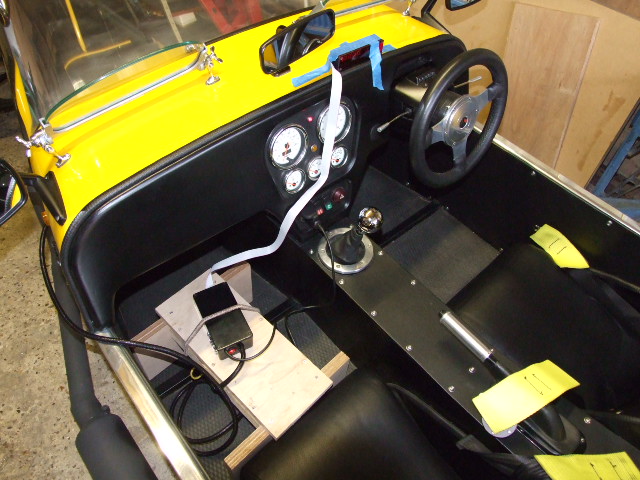
The first step was to find out whether the car would run at all: the ignition was turned on and the petrol pump made the right sort of pattering noises, so the regulator was set to the correct pressure - 2 psi - measured with a gauge screwed into the regulator. After that, the starting enrichment (SE, a.k.a. 'choke') was set on and the starter engaged. Within a second or so the engine was running, much to my surprise. It was running rough, but I guessed that this was entirely due to the carbs being out of balance. Approximate balancing was achieved by holding one end of a plastic tube in the trumpet of each carb, with the other end held to my ear. This was good enough to prove that everything was working correctly, and that a steady idle could be achieved.
The carbs were properly balanced using a flow meter that was pushed into the trumpet of each carb in turn, starting with the one that has the throttle cable attached. Surprisingly, I had got the balance reasonably close with the plastic tube - but the flow meter made accurate balancing a lot easier. One very obvious difference at this stage was the much improved tick-over. With the old Weber carb I could never maintain a decent idle below 1000-1200rpm, but With the properly balanced new carbs the engine would idle easily at 700-800rpm.
Finally a Colortune was used to check that the mixture was approximately in the correct area, before making any plans for tuning it properly.
The first thing I did was to take it out on the road for a test drive: generally it ran very well, but it was struggling at wide open throttle (WOT) - it just didn't want to go, and felt 'strangled'. After some messing around I managed to get some time with a fellow builder and his LM-1 AFR meter (air-fuel ratio). This told me that the car was running a bit rich at idle and mid-throttle, but appeared to be going very lean at WOT - about 20:1 air/fuel. Unfortunately it was hard to judge the exact situation as the engine's distress made staying at WOT difficult.
The correct sequence for tuning these carbs starts with getting the WOT mix right, which means the size of the main jet. Before fitting the carbs I had already drilled the jets out to 1.6mm, so the next step was to drill them out a bit more - 1.65mm. I then went out on the road again with my own AFR meter; immediately I could see that the tickover and mid-throttle mixture was a fair bit richer, but I had the same problem at WOT. However, the AFR meter did show that I was getting a rich mixture at WOT just before the power loss, which suggested that there was a fuelling problem (float height or the petrol supply). Because of this I decided to bite the bullet and replace the Facet fuel pump and Filter King regulator with an ex-bike fuel pump, as recommended by several other builders. The advantage of a bike pump is that they are self-regulating and supply petrol at the correct pressure for bike carbs, but at a high volume. Unfortunately, this wasn't the answer, and in all probability the original pump and regulator was perfectly OK!
Finally I decided to get an AFR meter of my own - a self-assembly kit called JAW (Just Another Wideband).

Using this setup I could see that in reality the engine was running extremely rich most of the time, and very rich at WOT (an AFR of around 10:1) - far too rich for proper combustion, hence the 'strangling' at full power. As it's quite difficult to drill holes smaller, I decided to make a new set of jets on my lathe. Initially I made one set of 1.5mm and another at 1.4mm: the 1.5mm set was still giving a rich mixture, but not quite as bad, and the WOT was far healthier; the 1.4mm set was even better, but the WOT AFR was still richer than the target figure of around 12.5:1. Finally I made one more set of jets at 1.3mm, which proved to be ideal - WOT AFR of around 12.5:1, with an over-run AFR of between 16:1 and 17:1 (it is quite normal to go very lean on over-run). Checking the plugs after a fairly hard run showed an almost ideal biscuit colour on the elctrodes, which was a huge improvement over the previous thick sooty coating.
The car ran extremely well after making these changes, with a very responsive throttle and good acceleration.
The only remaining shortcoming is the mid-range ratio, which remains at around 11.5:1, instead of being close to the ideal and most efficient ratio of 14.7:1 - although it is quite hard to achieve that figure with carburettors. This final adjustment requires needle adjustment, but the CBR600F-X carburettors have fixed-length needles, so now I have to find adjustable replacements.
| [Fitting the carbs] | [Final Verdict] |